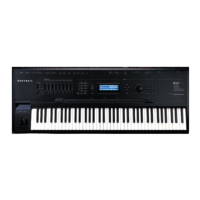9-12
Effects
Delays
Wet Bal (Wet Balance). Some reverb algorithms are actually two stereo reverbs in one, with each
one receiving a different mono signal. This balances the outputs of the two reverbs—0% means
they are being mixed equally.
Delays
There are two types of taps in the Multitap delays: The “Loop“ tap, which has a feedback loop
back to its input, and the numbered taps. The numbered taps can be single iterations or they can
repeat as part of a loop, but they do not have individual feedback paths.
Fdbk (Feedback) Level controls the repeating function of the Loop Tap. A setting of 0% means
there will only be a single delay, while a setting of 100% means the signal keeps repeating
without ever stopping.
Both types of taps are individually adjustable from 0 to 2.55 seconds. The Loop Crs and Ta pn
Crs (n being the number of the tap) parameters set the coarse value of the loop in 20-ms
increments, while the Loop Fine and Tap n Fine parameters set the fine value in 0.2-ms
increments.
In Delay algorithms that use tempo to determine tap lengths, there is a Te mp o parameter which
can be set from 1 to 255 BPM or to “System”. The Loop Length and Tap n Delays are then
expressed in beats relative to that overall Tempo.
Hold is a switch that, when turned on, “locks” any signal currently in the delay and plays it
until Hold is turned off. When Hold is on, no signal can enter the delay and Feedback is set to
100%. A good parameter to control with a footswitch.
Dry Bal (Balance) is the left/right balance of the dry signal. At -100%, only the left dry signal
goes to the left output, while at 100% only the right dry signal passes to the right output, and at
0%, equal amounts of the left and right dry signals pass to their respective outputs.
Tap n Level is the level of each numbered tap, from 0% to 100%, relative to the overall output of
the effect.
Tap n Bal is the left/right balance of each of the numbered taps. At -100%, only the left channel
of tap n goes to the left output, while at 100% only the right channel of tap n goes to the right
output. At 0%, equal amounts of the left and right channels of the tap pass to their respective
outputs. In some delays, pairs of taps (1 and 5, 2 and 6, etc.) are controlled together as stereo
pairs.
DelayScale lets you change the lengths of all the taps together. Its range is 0 to 10x.
☛Note that it is possible for the PC3 to run out of delay memory with over-generous settings of
DelayScale or very slow Tempos. Some Delay algorithms will simply go to a maximum value
and stay there, while in some, a calculation is made that automatically cuts the delay times in
half, thereby maintaining a relationship with tempo.
Complex Echo
This algorithm has two feedback taps per channel as well as three independent taps, and also a
feedback diffuser for “smearing” the delays. Feedback line 1 feeds the signal back to the delay
input of the same channel, while feedback line 2 feeds the signal back to the opposite channel.
FB2/FB1>FB is a balance control between feedback lines 1 and 2. 0% (minimum) turns off
feedback line 2, only allowing use of feedback line 1. 50% is an even mix of both lines, and 100%
(maximum) turns off line 1.
L Diff Dly and R Diff Dly adjusts the delay lengths of the diffusers. Range is 0 to 100 ms.

